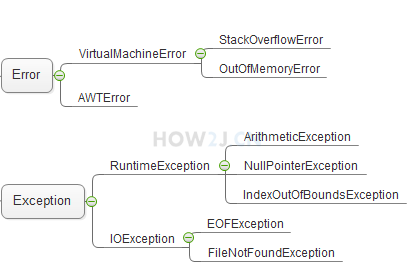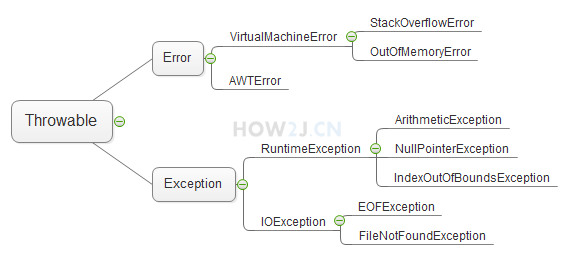(1)、异常定义:导致程序的正常流程被中断的事件,叫做异常。
(2)、异常处理常见手段: 【 try-catch 】、【 try-catch-finally 】、【 throws 】
注意:try-catch-fianlly
【
无论是否出现异常,finally中的代码都会被执行;
如果try块中有return,那么会先执行finally块中的语句,然后再return。
import java.io.File;
import java.io.FileInputStream;
import java.io.FileNotFoundException;
public class FinallyTest {
public static void main(String[] args) {
File f = new File("a.txt");
String result = open(f);
System.out.println(result);
}
public static String open(File f) {
FileInputStream fs = null;
try {
System.out.println("试图打开 a.txt");
fs = new FileInputStream(f);
return "成功打开!";
} catch (FileNotFoundException e) {
System.out.println("a.txt不存在");
e.printStackTrace();
return "打开失败";
} finally {
System.out.println("无论文件是否存在, 都会执行的代码");
}
}
}
输出结果:
】
(3)、异常分类
总体上异常分三类:
1. 错误
2. 运行时异常
3. 可查异常
[1]、可查异常 CheckedException : 即必须进行处理的异常,要么try-catch住,要么往外抛,谁调用,谁处理,比如 FileNotFoundException;
如果不处理,则编译无法通过。
import java.io.File;
import java.io.FileInputStream;
import java.io.FileNotFoundException;
public class CheckedExceptionTest {
public static void main(String[] args) {
File f= new File("d:/LOL.exe");
try{
System.out.println("试图打开 d:/LOL.exe");
new FileInputStream(f);
System.out.println("成功打开");
}
catch(FileNotFoundException e){
System.out.println("d:/LOL.exe不存在");
e.printStackTrace();
}
}
}
运行结果:
[2]、运行时异常 RuntimeException : 不是必须进行try catch的异常
常见运行时异常:
除数不能为0异常: ArithmeticException
下标越界异常: ArrayIndexOutOfBoundsException
空指针异常: NullPointerException 在编写代码的时候,依然可以使用try-catch、throws进行处理,与可查异常不同之处在于,即便不进行try catch,也不会有编译错误 ;
Java之所以会设计运行时异常的原因之一,是因为下标越界,空指针这些运行时异常太过于普遍,如果都需要进行捕捉,代码的可读性就会变得很糟糕。
public class ExceptionTest {
public static void main(String[] args) {
//任何除数不能为0:ArithmeticException
int k = 5/0;
//下标越界异常:ArrayIndexOutOfBoundsException
int j[] = new int[5];
j[10] = 10;
//空指针异常:NullPointerException
String str = null;
str.length();
}
}
运行结果:编译可以通过,但运行时会报错。
[3]、错误 Error : 指的是系统级别的异常,通常是内存用光了。
在默认设置下,一般java程序启动的时候,最大可以使用16m的内存;
【注意:与运行时异常一样,错误也是不要求强制捕捉的】
如例:不停的给StringBuffer追加字符,很快就把内存使用光了。抛出OutOfMemoryError
public class ErrorTest {
public static void main(String[] args) {
StringBuffer sb =new StringBuffer();
for (int i = 0; i < Integer.MAX_VALUE; i++) {
sb.append('a');
}
}
}
运行结果:
程序首先会运行几秒,然后,突然报错:↓ ↓ ↓
(4)、Throwable
Throwable是类,Exception和Error都继承了该类;
所以在捕捉的时候,也可以使用Throwable进行捕捉。
如图: 异常分Error和Exception
Exception里又分运行时运行时异常和可查异常。

import java.io.File;
import java.io.FileInputStream;
public class ThrowableTest {
public static void main(String[] args) {
File f = new File("d:/LOL.exe");
try {
new FileInputStream(f);
} catch (Throwable t) { //使用Throwable进行异常捕捉
t.printStackTrace();
}
}
}
运行结果:
(5)、创建自定义异常
public class MyException extends Exception{
public MyException(){
}
public MyException(String msg){
super(msg);
}
}




